Tags
amarula, asynpoeding, cocktails, cream, dessert, liqueur, marula, pudding, rainbow nation, South Africa
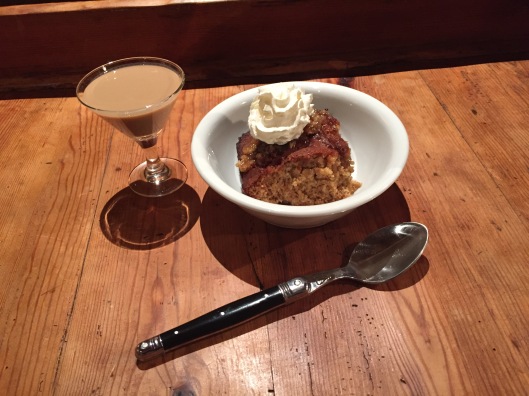
My Rainbow Nation Collection of Recipes – week 4
Although the sound of vinegar in a pudding is odd, this tastes great! It has a very subtle sweet and sour taste to it and is delicious served with custard or whipped cream.This is a very old traditional recipe but is still enjoyed by many South Africans today. It was often served after a Sunday lunch but I find it good for those cold winter nights! If you want to be 100% authentic, then you would cook it in a potjie (see last week’s post) over hot coals, but for our purposes, the stove top and oven will do just fine.
Next you might be wondering what the little glass in the photo is all about. That is a little bit of creamy, liquid happiness – Amarula.
Amarula is a South African cream liqueur made from the fruit of the Marula tree, also known as Sclerocarya birrea or “The Elephant Tree”, and cream. The fruit is fermented and then distilled in copper pot-stills. The marula liquor is then stored in small oak casks for two years before it is enriched with pure marula extract and blended with fresh cream. Amarula Cream is best served chilled, on the rocks or with crushed ice. It can also be used in countless desserts and cocktails.
Elephants enjoy eating the fruit of the marula tree. The story goes that Hare acted kindly towards Elephant during the year of the drought, and was rewarded with a tusk. When Hare planted the tusk in his garden, it grew into a beautiful fruit-bearing tree, which he could enjoy in time of famine. The elephant has since sought out his tusk by devouring hundreds of kilograms of fruit during the marula season. Because of the marula tree’s association with elephants, the distiller has made them its symbol and supports elephant conservation efforts. Isn’t that reason alone to buy a few bottles?
More about the Marula fruit: (taken from the Amarula website, http://www.amarula.co.za)
The exotic marula fruit is found only on the sub-Saharan plains of Africa, where it grows in the wild and bears fruit for just a few weeks a year. Not just totally delicious, it is also rich in vitamin C, potassium, calcium, magnesium as well as protein. Today marula trees grow abundantly in the wild and are found in many parts of South Africa, including the famous game reserve, Kruger National Park. They are also plentiful in Botswana, Swaziland, Namibia and Zimbabwe. The trees support an extensive ecosystem. Their cooling canopies provide habitats for a range of plants and grasses, while the fruit is eaten by elephants, rhino, warthog, kudu, baboons, vervet monkeys, zebra, porcupine and even millipedes. Their leaves are also eaten by a range of browsers, including domestic cattle. At the height of the African summer, from mid-January to mid-March, a sweet and enticingly tropical fragrance fills the air of the sub-Saharan plains. For that is when the marula fruits, heavy with goodness and flavour, drop to the ground and nature’s bounty is there for all to share. Many of the wild-growing trees, indigenous to sub-Saharan Africa, are found in the sub-tropical region of Phalaborwa in Limpopo Province. When the fruit falls to the ground, heavy with flavour and goodness, it is collected by the women of the local rural communities before being delivered to the Amarula production plant in Phalaborwa. The appeal of the marula fruit is only part of the story. A favourite amongst elephants, it is also revered as the food of kings amongst many sub-Saharan peoples. Many communities make a marula brew to present as an offering to the spirits of the ancestors or to honour their leaders. The trees themselves stand tall and crowned in leaves, providing generous shade. They are an important part of African community life and folklore. Marula trees often serve as meeting places for village gatherings and the spiritual centre for ritual activity. Known as a ‘Marriage Tree’ amongst the Zulu, the tree is believed to bestow vigour and fertility on those who marry beneath its branches. Even today, tribal wedding ceremonies are held in its shade. The hard stones inside the fruit are often dried and strung together in a necklace that traditionally symbolises love.
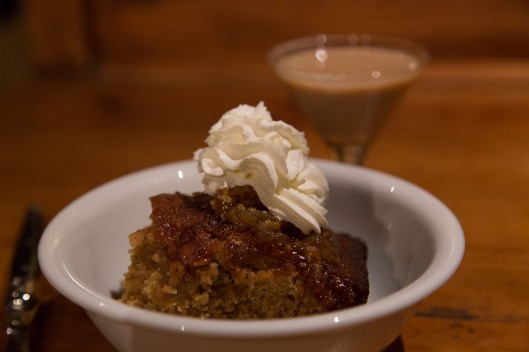 Back to our pudding. Vinegar pudding or Asynpoeding in Afrikaans. Try as I might, I could not find the historical antecedents of this pudding, but if anybody knows of an English, French or Dutch pudding that includes a syrup made from vinegar, I’d be very pleased to hear from you. You can use any kind of white vinegar – white wine, champagne, sherry or apple cider vinegar. I would not recommend strongly flavoured vinegars like malt or balsamic.
Back to our pudding. Vinegar pudding or Asynpoeding in Afrikaans. Try as I might, I could not find the historical antecedents of this pudding, but if anybody knows of an English, French or Dutch pudding that includes a syrup made from vinegar, I’d be very pleased to hear from you. You can use any kind of white vinegar – white wine, champagne, sherry or apple cider vinegar. I would not recommend strongly flavoured vinegars like malt or balsamic.
There will seem to be way too much syrup when you pour it over the batter – almost as much as the batter itself. Yes, the syrup will completely cover the batter like a lake, but this is normal. Don’t panic! As you bake, the syrup will soak into the batter and migrate to the bottom of the dish, so that once the pudding is baked, there will be sauce in the base of the dish to spoon over each serving.
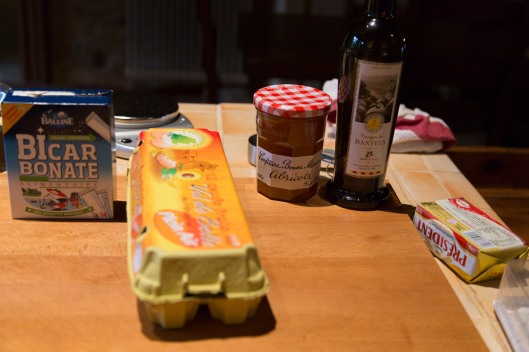
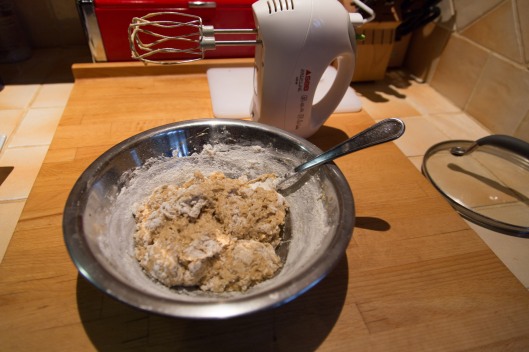
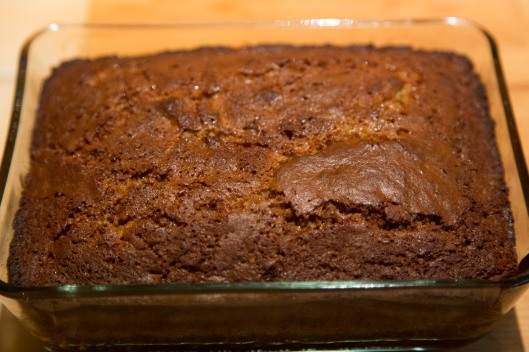
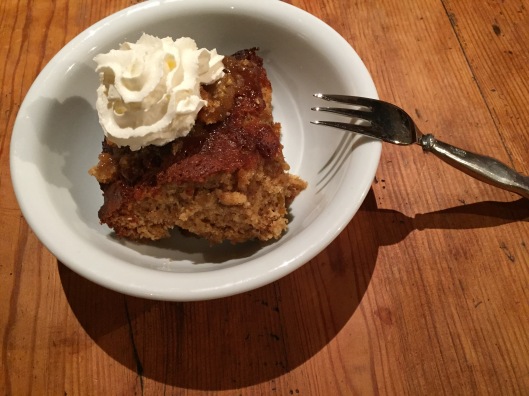 Serves 4 to 6
Serves 4 to 6
Ingredients:
pudding:
2 eggs
2 tablespoons sweet butter
1/2 cup soft brown sugar
185 g / 6 1/2 oz cake flour (self raising) – see note
2 teaspoons ground ginger
1/2 teaspoon ground nutmeg
1 teaspoon bicarbonate of soda
2 heaped tablespoons smooth apricot jam
note: if you do not have cake flour, you may use regular flour plus 3/4 teaspoon baking powder
sauce:
2 cups water
1 cup white sugar
1/2 cup white vinegar
Preparation:
Preheat the oven to 180 C / 350 F
Make the sauce:
Boil the water, sugar and vinegar for about 8 minutes
Set aside to cool
Make the batter:
Grease an ovenproof dish with butter, use a high sided dish due to the amount of liquid
Beat the eggs lightly
Cream the butter and brown sugar together in a large bowl
Add the eggs beating well
Sift the cake flour, nutmeg, ginger and bicarbonate of soda into another bowl
Add the dry mixture into the wet mixture, mixing well
Add the apricot jam and stir until well blended
Pour the cooled sauce into your ovenproof dish
Spoon the batter into the dish
Bake for 35 to 40 minutes until the pudding is golden brown
Serve hot with custard or whipped cream
Enjoy!

Just out of curiosity I researched Malva Pudding (another SA dish) and saw with interest the vinegar is added to the batter and the sauce is sweeter and poured over after baking. Can’t help wondering if the two are not somehow related. Now of course I’m confused as to whether I’ve been eating Malva or Asynpoeding. Both delicious. Laura
LikeLike
Good morning, they are in fact very similar and some people use the names interchangeably even but as you rightly noted, Malva is often a bit sweeter. The sauce can be poured either under or over the pudding, either way the batter soaks up most of it. So, feel free to call it whichever name you fancy, most people do. Just enjoy eating it:)
LikeLike
A moment on the lips … forever on the hips 🙂 Very yummy in winter. Laura
LikeLiked by 1 person
Nice! Why don’t you join WordPress.com network?!
Here’s a link: http://jumzler.com/j/getting-started/embeds/wordpress.com
Enjoy 🙂
LikeLike
Thanks. I am on WordPress.
LikeLike
Hi Nadia, This is absolutely lovely 🙂 One of those ‘warming’ desserts.
Looking forward to trying your recipe.
LikeLike
It is a perfect winter dessert. Enjoy!
LikeLike
What an absolutely heavenly sounding pud. It strikes like a cross between treacle sponge, sticky toffee and those heavenly lemon sponges that you heft hot water onto and somehow they make their own sauce. But the vinegar is what really catches my eye – being of a less than sweet tooth (though of course the sweetest disposition) I think that little sour note will be just the thing. At the moment I am in the land of apple vinegar so I will give it a whirl with that – back at home in the Cantal it would certainly be a light vinaigre blanc I think 🙂
LikeLike
Oh yes! How right you are. It really is a cross cultural mix. The vinegar gives it just a subtle touch. I think your vinaigre blanc will be perfect.
LikeLiked by 1 person
Adding vinegar sounds really interesting and I’ll have to give this recipe a go at some point: it looks great! 🙂
LikeLike
Thanks. You will love it, I am sure of it. Do pop back and let me know.5
LikeLike
This is so interesting. I must make sure Sue takes a look as she is on a vinegar kick and this would put to very good use all her vinegars.
LikeLike
Oh yes, she is bound to know it already being South African but might not have made it for awhile. As you say, great use of vinegar that needs to be used. Where in Cape Town does she live? I will be there soon to speak at a conference of chefs and sommeliers etc.
LikeLike
This actually sounds really yummy! I add vinegar to cake which helps it bake. I need to try this someday.
http://www.mintnotion.com
LikeLike
Please do, it is a very unique but delicious flavour.
LikeLike
I’m so glad you mentioned not to use balsamic vinegar, I probably would’ve tried it, it’s my vinegar of choice.. However I think it’s wise to stick to your recipe as close as I can..
This is the first recipe I’ve viewed on your blog and will be making this..
Your pictures, the history and recipe instructions are pleasing and easy to view and read.. You are one to follow 😊
LikeLike
Thank you very much. Balsamic is my vinegar of choice for about 75% of recipes but really would not work for this unless you wanted a screw your face up dessert.
LikeLiked by 1 person
Lol..
LikeLike